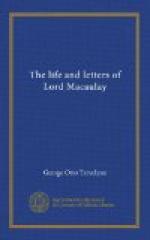One result of political disturbance in any quarter of the globe is to fill the scene of action with young members of Parliament, who follow Revolutions about Europe as assiduously as Jew brokers attend upon the movements of an invading army. Macaulay, whose re-election for Calne had been a thing of course, posted off to Paris at the end of August, journeying by Dieppe and Rouen, and eagerly enjoying a first taste of continental travel. His letters during the tour were such as, previously to the age of railroads, brothers who had not been abroad before used to write for the edification of sisters who expected never to go abroad at all. He describes in minute detail manners and institutions that to us are no longer novelties, and monuments which an educated Englishman of our time knows as well as Westminster Abbey, and a great deal better than the Tower. Everything that he saw, heard, ate, drank, paid, and suffered, was noted down in his exuberant diction to be read aloud and commented on over the breakfast table in Great Ormond Street.
“At Rouen,” he says, “I was struck by the union of venerable antiquity with extreme liveliness and gaiety. We have nothing of the sort in England. Till the time of James the First, I imagine, our houses were almost all of wood, and have in consequence disappeared. In York there are some very old streets; but they are abandoned to the lowest people, and the gay shops are in the newly-built quarter of the town. In London, what with the fire of 1666, and what with the natural progress of demolition and rebuilding, I doubt whether there are fifty houses that date from the Reformation. But in Rouen you have street after street of lofty stern-looking masses of stone, with Gothic carvings. The buildings are so high, and the ways so narrow, that the sun can scarcely reach the pavements. Yet in these streets, monastic in their aspect, you have all the glitter of Regent Street or the Burlington Arcade. Rugged and dark, above, below they are a blaze of ribands, gowns, watches, trinkets, artificial flowers; grapes, melons, and peaches such as Covent Garden does not furnish, filling the windows of the fruiterers; showy women swimming smoothly over the uneasy stones, and stared at by national guards swaggering by in full uniform. It is the Soho Bazaar transplanted into the gloomy cloisters of Oxford.”
He writes to a friend just before he started on his tour: “There is much that I am impatient to see, but two things specially,— the Palais Royal, and the man who called me the Aristarchus of Edinburgh.” Who this person might be, and whether Macaulay succeeded in meeting him, are questions which his letters leave unsolved; but he must have been a constant visitor at the Palais Royal if the hours that he spent in it bore any relation to the number of pages which it occupies in his correspondence. The place was indeed well worth a careful study; for in 1830 it was not the orderly and decent bazaar of the Second Empire, but was still that compound of Parnassus and Bohemia which is painted in vivid colours in the “Grand Homme de Province” of Balzac,—still the paradise of such ineffable rascals as Diderot has drawn with terrible fidelity in his “Neveu de Rameau.”




